Table of Contents
** Minutes
What makes up logistics costs?
7 tips to reduce logistics costs
Running a successful ecommerce business involves managing a tight budget, yet many businesses unknowingly overspend in many areas. One of the costliest offenders is the supply chain.
When there’s pressure to be competitive, offer customers the best service, and provide a memorable experience — all while being profitable — how do you keep logistics costs down, especially as you encounter new challenges as you grow?
Improving your bottom line is much easier said than done. Here are some tips on how to save on logistics costs and grow your business.
What are logistics costs?
Logistics costs are all of the expenses incurred moving product — from sourcing raw materials to delivering customer orders and every step in between.
What makes up logistics costs?
Logistics costs throughout the retail supply chain are paid to manufacturers, trucking companies, third-party logistics service providers, shipping carriers, freight brokers, and a variety of other vendors. Companies track logistics costs in different ways, some getting as granular as calculating inventory depreciation.
What is logistics costing your business? Read on to find out.
Transportation and shipping
Transportation costs are one of the largest buckets within the supply chain and include getting your inventory from the manufacturer to your warehouse and then to your customers.
Freight shipping is the transportation of inventory via air, land, or sea that takes place between a freight broker and merchant, often across countries.
Transportation costs also include delivering orders to customers at residential addresses via shipping carriers.
Warehouse rent
Starting in 2021, logistics warehouse tenants can expect to see a 10% rate hike due to a high demand for warehouse expansion and construction. Just the cost of renting a warehouse can quickly cut into profit margins.
Warehouse expenses can be huge for ecommerce businesses including signing a lease and purchasing land, which are often long-term commitments.
You need an ecommerce warehouse that meets your needs and plans for growth in terms of square footage, loading docks to receive and ship inventory, and more.
Inventory storage and allocation
The cost of just holding or storing inventory can be high, especially if you’re outsourcing inventory storage, as it is a variable cost. The more inventory you have, the more you will pay.
Inventory accounting is the tracking and accounting for changes in the value of inventory over time as it relates to manufacturing and costs of goods sold. It aims to help properly value your assets or goods sold and budget for the inventory you need to purchase in the future. That way, you can allocate product efficiently.
“With ShipBob, we have access to live inventory management, knowing exactly how many units we have in Texas vs. Chicago vs. New York. It not only helps with our overall process in managing and making sure our inventory levels are balanced but also for tax purposes at the end of the year.”
Matt Dryfhout, Founder & CEO of BAKblade
Supplies and equipment in the warehouse
In addition to acquiring a warehouse and your inventory, there are many other supplies needed to manage all of the moving pieces.
To make use of the space that holds your inventory, you need proper shelving units and pallet racks.
To move the goods in your warehouse, you need forklifts, conveyors, and other equipment.
For packaging, you need shipping supplies, boxes, envelopes, tape, dunnage, labels, printers, and other packing materials.
To manage the warehouse, you need to pay for technology such as a warehouse management system, internet, taxes, utilities, office supplies, and other administrative expenses.
Staff labor
The ‘handling’ part of shipping and handling requires people to move inventory and pack boxes in your warehouse. You will also need management, customer service, and other team members performing inbound and outbound logistics tasks based on your business’s unique needs.
Expenses in this bucket may also include recruiting and hiring staff labor for both hourly employees and management, determining employee benefits, getting workers’ comp and liability insurance, and managing payroll.
How logistics drives revenue
Most people think about supply chain management and logistics and as a cost center, and few recognize it as or execute it appropriately to be a revenue-driver. In addition to reducing logistics costs (more on that below!), there are several ways that logistics systems can actually drive new revenue for your ecommerce business.
1. Reduce cart abandonment rate
Cart abandonment is one of the most pressing problems of optimizing an online store. Customers now expect low cost or free shipping and will make purchase decisions accordingly.
Without spending any marketing dollars, you can recover more ecommerce sales simply by offering affordable 2-day shipping.
“We understand that whatever Amazon does, we also need to do or we are going to lose business. The cost of offering free 2-day shipping through ShipBob is more than covered and offset by all of the additional orders and revenue we’ve gotten as a result. We’ve seen an 18% reduction in cart abandonment.”
Founder of My Calm Blanket
2. Increase average order value
Have you ever spent more money online or added an item to your cart to qualify for free shipping?
If done right, implementing a minimum spend threshold on your store gets you a higher average order value (AOV), while covering the costs of shipping.
Encouraging shoppers to spend more than what your customers typically spend in exchange for free shipping means extra revenue for you.
3. Happy customers improve your bottom line
Offering something for free that is normally a significant portion of a sale might sound counterintuitive but hear us out: Free shipping can not only get more shoppers to complete their purchases and spend more money, but also lead them to becoming lifelong customers.
When shoppers know they can count on you to meet their delivery needs and preferences, they will come back.
“We’ve seen a spike in conversions since applying ShipBob’s 2-Day Express Shipping, which lets us to stay ahead of the competition that offers similar products and is seen by our customers. Our job is to drive traffic to our website and 2-day shipping is certainly an option that a lot of our customers are very happy with.”
Matt Dryfhout, Founder & CEO of BAKblade
Today, affordable, fast delivery makes customers happy. They turn into repeat buyers, and repeat buyers are a lot freer to acquire than new customers.
7 tips to reduce logistics costs
Now that you understand what logistics costs are and ways to try to offset them, let’s dive into how you can spend less on logistics, whether it’s reducing shipping costs or cutting manufacturing costs and lead times.
1. Find a source closer to home
Product sourcing is an expensive logistics cost. If you’re importing your products from China because they are cheaper than being made in the US, you may want to look at how much the shipping costs are, especially with tariffs rising.
The right manufacturer can cut logistics costs for your business but will depend on the type of products you sell, the supplies needed to create them, the previous experience of the supplier, and much more.
2. Consolidate items to optimize purchasing and storage
Evaluate your SKUs to see if you can optimize the products you offer. The larger the product catalog you have, the more expensive it will be to store and manage your inventory.
Look at your sales data over time to gain insight before you make any decisions. Ask the following questions:
- Which products are driving revenue (e.g., do 10% of your SKUs make up 90% of your sales?)
- Which items sell at a faster rate than others and need to be replenished more often?
- Are there items that aren’t selling much at all (looking at each color and/or size)?
- Are certain combinations of items being purchased together often?
- Which items are driving the most returns?
Understanding how your SKUs are performing can help to identify which ones you may want to retire because they’re not selling (which can cause dead stock), where to focus and put more advertising dollars behind, and even if you need to tweak your ecommerce returns policy.
3. Review your carrier options
Carriers update prices annually, so it may be smart to reevaluate prices across their services to understand which options are most cost-effective for your business.
Ecommerce shipping costs take many variables into account and can have a huge impact on your overall logistics costs. Review each of the following carriers’ pricing to calculate your potential shipping costs:
4. Buy bulk packaging
Packaging may seem like a minor expense, but it adds up over time. Once you know your order weights and dimensions and choose the correct combination of boxes and/or poly mailers, you can get volume discounts from purchasing packaging and packing supplies in bulk.
Though there is a higher cost on the front end, it will save you money in the long run when you see a reduction is your average per-order cost.
5. Reorganize your operations
“We’ve always done it that way” is the worst excuse used in business. Review your logistics costs, processes, tools, and metrics often to determine if changes need to be made.
Here are a few operational questions to get you thinking:
- Does your warehouse layout make sense? Are you utilizing the space as best you can?
- Are pick lists for pickers optimized based on nearby inventory used in the consecutive orders they are working on?
- Are packing stations set up efficiently?
- Are inventory levels accurate and organized?
- Is your staff productive and working at a low error rate?
- How much time does each activity take to be completed in the warehouse? Do you know this at the employee level?
- What is your average turnaround time from when an order is placed to when it’s shipped out?
- Are you missing any shipping deadlines?
Answers to these questions may help you identify if you need to reorganize pallets, shelves, bins, or racks vertically or horizontally, repurpose staff and help them be more efficient, improve processes that are costing you the most, and even overhaul your operations.
6. Distribute inventory across several regions
Shipping zones help determine shipping costs by charging more to ship to distances that are farther away. When you ship from just one location, you ship to customers both near and far.
This may seem like another counterintuitive concept, but splitting up inventory in multiple warehouses across the country can actually reduce logistics costs by eliminating the need to ship to the highest, most expensive zones.
You can save money by utilizing ground shipping rather than air shipping for expedited delivery, using logic to route each order to the facility that has inventory closest to the end customer.
Review your order history data and analyze your customers’ zip codes to find common groupings of shipping destinations. From there, you will be able to tell which regions are in the highest zones and costing you the most.
For example, if you’re currently shipping exclusively from the East Coast but you have a high concentration of customers on the West Coast, you can eliminate shipping to higher zones by having inventory closer to the West Coast customers.
You need the volume to support it though — if you’re only shipping 100 orders per month, it will not be cost-effective for you to store your inventory in more than one fulfillment center.
“Because 17% of our orders are shipped to New York, we are moving next into ShipBob’s Northeast fulfillment center. This will help reduce the shipping zones, and, as a result, our average time in transit and shipping cost.”
Steve Staffan, founder and CEO of Brummell
7. Switch to a 3PL
Many ecommerce businesses outsource fulfillment logistics to a third-party logistics (3PL) company for a more cost-effective and time-saving option.
“Last July, Prymal reached $40,000 in revenue. After switching to ShipBob just four months later in November, we are reaching $160,000 a month in revenue — that’s 300% growth. We’re also saving $8,000 per month in fulfillment costs.”
Courtney Lee, founder of Prymal
Rather than keep this part of the supply chain in-house and invest in a warehouse themselves (as well as a logistics director to run it), many businesses partner with a 3PL that has multiple warehouses. This eliminates logistics costs such as rent, equipment, and labor.
3PLs keep logistics costs in check
3PLs are logistics companies that are specialize in inventory storage, packaging, and shipping. Of course 3PLs charge fulfillment costs, but it is often overall more cost-effective to leverage their scale and resources rather than attempt to do it yourself.
Here are a few key ways 3PLs like ShipBob reduce logistics costs.
Affordable warehousing costs
Warehouse space is getting more expensive, and demand for it continues to soar. When you partner with a 3PL, you can store your inventory in parts of their fulfillment center along with other ecommerce businesses. This way, warehousing costs are spread across many businesses.
By only paying for what you use, you don’t have to worry about overpaying for a space that you might never fill out.
If you grow faster than expected, 3PLs help you scale, whether it’s getting additional shelf space for a new product launch, or expanding into more of their fulfillment centers to better serve different regions where your customers reside with faster, more affordable shipping.
You get the geographic footprint needed to reduce logistics costs that you could never afford on your own.
“The more fulfillment centers we have inventory in, the more potential shipping addresses we can offer inexpensive 2-day ground shipping to. And the more people that we offer the benefit of free 2-day shipping to, the more conversions we get.”
Founder of My Calm Blanket
Eliminate running a warehouse and operations teams
Warehouse management is a complex operation, between hiring and training people, purchasing equipment and tools, continuously replenishing supplies, and shipping everything accurately and on time.
When you outsource fulfillment, you don’t need to worry about any of that. 3PLs are experts in driving efficiencies to reduce logistics costs and avoid delays.
Bulk carrier discounts
With thousands of customers, 3PLs are able to negotiate bulk discounts from shipping carriers like UPS, USPS, FedEx, and DHL to provide better rates for expedited shipping, 2-day shipping, international shipping, and more. Of course, the more packages you ship, the better rates you can get to further reduce logistics costs.
Technology and forecasting
With the high volume of orders they ship and their breadth of experience, most 3PLs have best-in-class technology and tools. This includes inventory forecasting so you know when to repurchase product to never run out of stock and also project any changes in demand during seasonal peaks.
Inventory management is simplified with a 3PL because they handle the organization, real-time tracking, and handling of product for you. Additionally, different 3PLs have various tools and integrated systems to handle everything from returns to EDI compliance.
Scalability for seamless growth
Ecommerce fulfillment becomes more challenging to manage as your business grows. By outsourcing fulfillment, you can get time back to focus on the tasks that drive new customers to your website and bring in ecommerce sales.
You no longer have to complete manual tasks as 3PLs help you automate shipping and logistics processes for everything from ecommerce order tracking to initiating a return, so you don’t have to think about it.
ShipBob’s advanced software helps us quickly understand shipping costs and how to improve shipping times by being closer to where our customers are.”
Andrea Lisbona, Founder & CEO of Touchland
Since outsourcing fulfillment to ShipBob, ecommerce businesses have experienced the following:
- Saved 120+ hours per week across 3 employees
- Grew their business 291% in 3 years
- Reduced US shipping costs by 70%
3PLs let businesses focus on higher dollar activities and truly grow due to infrastructure, technology, and scalability improvements.
Conclusion
There are many hidden logistics costs that can eat up any business’s margin. If you’re looking to keep logistics costs down and want to hand off time-consuming tasks like order fulfillment and shipping, check out ShipBob.
With a network of fulfillment centers across the United States, technology that integrates with the leading ecommerce stores and platforms, discounted shipping rates, and a variety of services to meet your needs, ShipBob can not only lower logistics costs but help you drive revenue.



